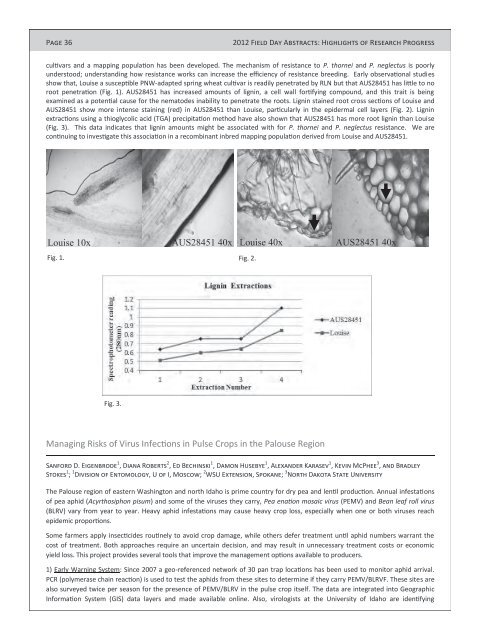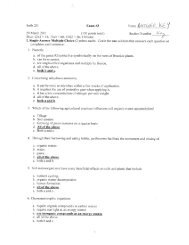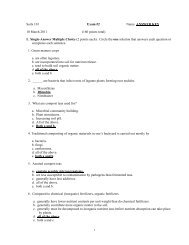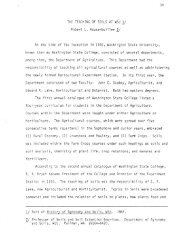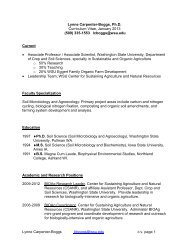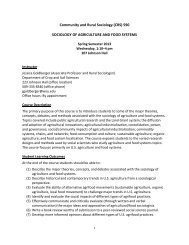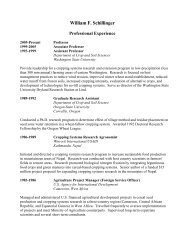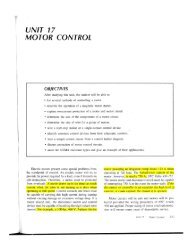2012 Dryland Field Day Abstracts - Dept. of Crop and Soil Sciences ...
2012 Dryland Field Day Abstracts - Dept. of Crop and Soil Sciences ...
2012 Dryland Field Day Abstracts - Dept. of Crop and Soil Sciences ...
You also want an ePaper? Increase the reach of your titles
YUMPU automatically turns print PDFs into web optimized ePapers that Google loves.
Page 36<br />
<strong>2012</strong> <strong>Field</strong> <strong>Day</strong> <strong>Abstracts</strong>: Highlights <strong>of</strong> Research Progress<br />
cultivars <strong>and</strong> a mapping population has been developed. The mechanism <strong>of</strong> resistance to P. thornei <strong>and</strong> P. neglectus is poorly<br />
understood; underst<strong>and</strong>ing how resistance works can increase the efficiency <strong>of</strong> resistance breeding. Early observational studies<br />
show that, Louise a susceptible PNW-adapted spring wheat cultivar is readily penetrated by RLN but that AUS28451 has little to no<br />
root penetration (Fig. 1). AUS28451 has increased amounts <strong>of</strong> lignin, a cell wall fortifying compound, <strong>and</strong> this trait is being<br />
examined as a potential cause for the nematodes inability to penetrate the roots. Lignin stained root cross sections <strong>of</strong> Louise <strong>and</strong><br />
AUS28451 show more intense staining (red) in AUS28451 than Louise, particularly in the epidermal cell layers (Fig. 2). Lignin<br />
extractions using a thioglycolic acid (TGA) precipitation method have also shown that AUS28451 has more root lignin than Louise<br />
(Fig. 3). This data indicates that lignin amounts might be associated with for P. thornei <strong>and</strong> P. neglectus resistance. We are<br />
continuing to investigate this association in a recombinant inbred mapping population derived from Louise <strong>and</strong> AUS28451.<br />
Louise x x<br />
Fig. 1.<br />
Fig. 3.<br />
Louise x<br />
Managing Risks <strong>of</strong> Virus Infections in Pulse <strong>Crop</strong>s in the Palouse Region<br />
Sanford D. Eigenbrode 1 , Diana Roberts 2 , Ed Bechinski 1 , Damon Husebye 1 , Alex<strong>and</strong>er Karasev 1 , Kevin McPhee 3 , <strong>and</strong> Bradley<br />
Stokes 1 ; 1 Division <strong>of</strong> Entomology, U <strong>of</strong> I, Moscow; 2 WSU Extension, Spokane; 3 North Dakota State University<br />
Fig. 2.<br />
The Palouse region <strong>of</strong> eastern Washington <strong>and</strong> north Idaho is prime country for dry pea <strong>and</strong> lentil production. Annual infestations<br />
<strong>of</strong> pea aphid (Acyrthosiphon pisum) <strong>and</strong> some <strong>of</strong> the viruses they carry, Pea enation mosaic virus (PEMV) <strong>and</strong> Bean leaf roll virus<br />
(BLRV) vary from year to year. Heavy aphid infestations may cause heavy crop loss, especially when one or both viruses reach<br />
epidemic proportions.<br />
Some farmers apply insecticides routinely to avoid crop damage, while others defer treatment until aphid numbers warrant the<br />
cost <strong>of</strong> treatment. Both approaches require an uncertain decision, <strong>and</strong> may result in unnecessary treatment costs or economic<br />
yield loss. This project provides several tools that improve the management options available to producers.<br />
1) Early Warning System: Since 2007 a geo-referenced network <strong>of</strong> 30 pan trap locations has been used to monitor aphid arrival.<br />
PCR (polymerase chain reaction) is used to test the aphids from these sites to determine if they carry PEMV/BLRVF. These sites are<br />
also surveyed twice per season for the presence <strong>of</strong> PEMV/BLRV in the pulse crop itself. The data are integrated into Geographic<br />
Information System (GIS) data layers <strong>and</strong> made available online. Also, virologists at the University <strong>of</strong> Idaho are identifying<br />
x


